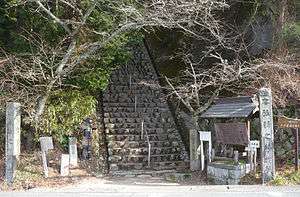Chihaya Castle
| Chihaya castle 千早城 | |
|---|---|
| Mount Kongō, Osaka Prefecture, Japan | |
 | |
| Coordinates | 34°25′2.01″N 135°39′4.31″E / 34.4172250°N 135.6511972°E |
| Type | Yamashiro |
| Site information | |
| Controlled by | Kusunoki Masashige (1332-1390) |
| Condition | Not extant |
| Site history | |
| Built | 1332 |
| Built by | Kusunoki Masashige |
| In use | 1332-1390 |
| Materials | Wood, earthwork |
| Battles/wars | Siege of Chihaya (1333) |
| Garrison information | |
| Garrison | about 2,000 |
Chihaya Castle (千早城 Chihaya-jō) was a Japanese castle, constructed in 1332 by Kusunoki Masashige. Consisting primarily of wooden and earthworks defenses, Chihaya stands as a keen example of fortress design of Japan's Nanboku-chō period. Located on Mount Kongō in Kawachi Province, it survived a siege in 1333, but was later conquered by forces of the Ashikaga shogunate in 1390 and then abandoned.
Along with Kami-Akasaka Castle (赤坂城), another nearby mountain fortress, Chihaya served as the base of operations for Kusunoki, and the core of his defenses, in his campaigns on behalf of Emperor Go-Daigo against the Hōjō clan. Constructed a year after the fall of Akasaka, Chihaya was intentionally designed to be stronger, and when it was attacked the following year, in 1333, Kusunoki successfully resisted the siege. Moveable bridges were among the fortress' chief defensive measures, alongside its wooden walls, earthwork defenses, and strategic location on Mt. Kongō. The fortress was surrounded with felled trees and boulders, which could be rolled down the mountain on an approaching army, and screens of brush were used to help protect from arrows.
Following the successful defense in 1333, the fortress saw little action until its fall in 1390. Though it was never formally destroyed in battle, it is unlikely that any significant elements of the fortress survive today.
References
 Media related to Chihaya Castle at Wikimedia Commons
Media related to Chihaya Castle at Wikimedia Commons- Frederic, Louis (2002). "Chihaya-jō." Japan Encyclopedia. Cambridge, Massachusetts: Harvard University Press.
- Sansom, George (1961). "A History of Japan: 1334-1615." Stanford, California: Stanford University Press. pp123–4
- Turnbull, Stephen (1998). 'The Samurai Sourcebook'. London: Cassell & Co.
- Motoo, Hinago (1986). Japanese Castles. Tokyo: Kodansha. pp. 200 pages. ISBN 0-87011-766-1.
.jpg)